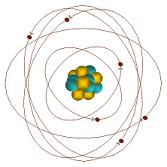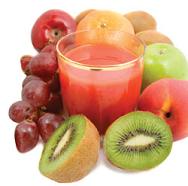The Antioxidant Bible
 Antioxidant Girl |
Instead of thinking about things you should not eat, consider foods you can add to your eating plan to help fight disease. One disease or condition that is common to all animals and people is called oxidation.
Like rust on a car, oxidation can cause damage to cells and may contribute to aging. Oxidation causes the formation of substances called free radicals, which is the primary cause of age related skin wrinkles and pigment discoloration. This is why we combat oxidation with antioxidants, which help keep wrinkles and pigmentation at bay.
During exercise, oxygen consumption is increased by 10 times or more, which leads to a significant increase in the production of oxidants. This results in damage that contributes to muscular fatigue during and after exercise. Delayed Onset Muscle Soreness (DOMS), which is an inflammatory response that occurs typically within 24 hours after strenuous exercise, is also associated with oxidative stress.
Worse yet, the brain is uniquely vulnerable to oxidative injury, due to its high metabolic rate and elevated levels of polyunsaturated lipids, the target of lipid peroxidation (creation of unstable molecules containing more oxygen than usual).
Project Swole Chemistry 101
Before we can understand free radicals, we must understand a bit about cells and molecules. The human body is composed of many different types of cells, which are composed of many different types of molecules. Molecules consist of one or more atoms of one or more elements joined by chemical bonds.
 Atom Diagram |
Atoms consist of a nucleus, which in turn consist of neutrons, protons and electrons. The number of protons (positive charge) in the atom’s nucleus determines the number of electrons (negative charge) surrounding the atom. It is the electrons that are involved in chemical reactions and are the substance that bonds atoms together to form molecules.
Electrons orbit an atom in one or more rings or shells, which are filled from the inner most ring to the outer most ring, with each ring containing 2n2 where n is the ring number. For example the first ring (n = 1) contain 2(1)2 = 2 electrons, while the third ring (n = 3) contains 2(3)2 = 18 electrons, etc…
The number of electrons in an atom’s outer shell is the main factor that determines that atom’s chemical behavior. Atoms strive to fill all of their rings with electrons and will rapid engage in chemical reactions when their outer rings have one or more missing electrons, while an atom with a full outer shell (an inert atom, which has maximum stability) tends not to participate in chemical reactions.
Atoms try to reach maximum stability by:
- Stealing or dropping electrons to either fill or empty the outer shell
- Sharing the electrons in the outer shell by bonding together with other atoms
Free Radicals
Bonds do not normally split in a way that leaves an atom with an odd, unpaired electron. But when this does happen (with weak bonds) free radicals are formed. Free radicals are very unstable and react quickly with other compounds, trying to recapture the needed electron to gain stability.
Free radicals generally attack the nearest stable molecule in an attempt to steal its electron. When the molecular victim loses the electron that once made it stable, it becomes a free radical itself, thus beginning a chain reaction. Once this cycle has begun, it can often have a cascading waterfall effect that results in the disruption of the overall living cell.
Some free radicals arise normally during metabolism, while other free radicals are purposefully created by the body’s immune system to neutralize viruses and bacteria. Environmental factors such as pollution, radiation, cigarette smoke and herbicides can facilitate this process, creating unnecessary free radicals.
The body can usually handle a normal amount of free radicals, unless antioxidants are unavailable. If free radical production becomes excessive or antioxidants are used up, cellular damage can occur. The free radical damage that accumulates with age is particularly important, and can be partially protected against by ingesting as many antioxidants as possible.
Antioxidants
Antioxidants help prevent oxidation, may help increase immune function, and possibly decrease risk of infection and cancer. Most people can benefit by adding foods rich in antioxidants, naturally occurring plant substances that help block bad free radicals in our bodies.
Antioxidants neutralize free radicals by donating one of their own electrons, ending the electron-stealing reaction. The antioxidant nutrients themselves do not become free radicals by donating an electron because they are stable in either form. They act as scavengers, helping to prevent cellular damage and disease.
Acai berries have one of the highest total antioxidant concentrations of all fruits and vegetables on the planet, which has led many people to include an acai berry diet pill in their diet and to search for acai berry diets and acai berry weight loss strategies.
You can get your own free trial of acai berry by clicking here.
Here are some other healthy foods you can eat to help boost antioxidant levels:
- beans: red beans, black beans, pinto beans, and lentils
- green tea
- red grapes (or wine, but be careful as developing a wine habit will add excessive calories to your daily intake)
- blueberries
- cherries
- white potatoes
- artichokes
- whole grains
- nuts and seeds
In general, fruits and vegetables provide many important nutrients including antioxidants such as vitamin C, vitamin E, beta-carotene and lycopene.
Vitamin C and Vitamin E
The vitamins C and E are thought to protect the body against the destructive effects of free radicals.
- Vitamin E is the most abundant fat-soluble antioxidant in the body. This is one of the most efficient chain-breaking antioxidants available, and is the primary defender against oxidation and lipid peroxidation.
- Vitamin C is the most abundant water-soluble antioxidant in the body. This acts primarily in cellular fluid, and is the most efficient at combating free-radical formation caused by pollution and cigarette smoke. Vitamin C also helps return vitamin E to its active form.
Foods containing a high concentration of vitamin C:
 Antioxidant Fruit Juice |
- citrus fruits: oranges, limes, lemons
- green peppers
- strawberries
- guava (tropical)
- plums
- grapefruit
- black currant
- tamarillo
- rosehip
- persimmon
- kiwi
- melon: honeydew, cantelope, watermelon
- jujube
Foods containing a high concentration of vitamin E:
- wheat germ oil
- almonds, dry roasted
- sunflower seed kernels, dry roasted
- sunflower oil
- safflower oil
- liver oil
- hazelnuts, dry roasted
- peanut butter
- peanuts, dry roasted
- corn oil
- spinach
- soybean oil
- whole grains
- green leafy vegetables
Carotenoids, Beta-carotene, and Vitamin A
A few of the better known antioxidants include carotenoids, which gives fruits and vegetables their deep rich colors. Plant carotenoids are the primary dietary source of vitamin A worldwide. The most efficient pro-vitamin A carotenoid is beta-carotene, which is abundant in yellow and orange fruits.
Vietnam gac has by far the highest content of beta-carotene of any know fruit or vegetable, 10 times higher than carrots, for example. Unfortunately, gac is quite rare and unknown outside its native region of SE Asia.
Foods containing a high level of carotenoids:
- apricots
- mangoes
- papayas
- pumpkin
- cantaloupes
- sweet potatoes (yams)
- carrots
- red peppers
- Vietnam gac (Momordica Cochinchinensis Spreng)
- green leafy vegetables: spinach, kale, sweet potato leaves, and sweet gourd leaves
- broccoli
- squash
- tomatoes
- kale
- collards
Foods containing vitamins C and E are also good sources of antioxidants, as well as selenium and zinc.
Lycopene
Lycopene is a pigment that gives vegetables and fruits, such as tomatoes, pink grapefruit and watermelon, their red color. In recent years, lycopene has received a lot of attention from researchers because it also has strong antioxidant capabilities. Several studies indicate that consumption of lycopene-rich foods is associated with a lower risk of prostate cancer and cardiovascular disease.
You can only obtain the benefits of lycopene by eating lycopene-rich foods, as it is not manufactured by the body. Canned tomato products, such as spaghetti sauce, tomato juice, ketchup and pizza sauce are by far the major sources of lycopene for most Americans. Other fruits and vegetables such as watermelon and pink grapefruit also provide lycopene, but in smaller amounts.
Other Antioxidants
There are some other important antioxidants that we haven’t really gone over yet, such as:
- selenium
- fish & shellfish
- red meat
- grains
- eggs
- chicken
- garlic
- phytochemicals
- flavonoids / polyphenols
- soy
- red wine
- purple grapes
- pomegranate
- cranberries
- tea
- lutein – dark green vegetables such as kale, broccoli, kiwi, Brussels sprouts and spinach
- lignan
- flax seed
- oatmeal
- barley
- rye
- flavonoids / polyphenols
- antioxidants with additional vitamin qualities
- Coenzyme Q10 (CoQ10)
- glutathione
- antioxidant enzymes made by the body
- superoxide dismutase (SOD)
- catalase
- glutathione peroxidase
Antioxidants work in a variety of ways to reduce the effects of free radicals. They can greatly decrease the damage caused by free radicals, stop them from forming to begin with, or oxidize them through a stabilizing chemical reaction to neutralize their harmful effects.
There are many vitamins, minerals, enzymes, and herbs that act as antioxidants or aid in the production of them. The best way to make sure you have covered all the bases in neutralizing free radicals is to eat the right foods and to supplement with a wide variety of antioxidants.
The best antioxidant supplements that I have found include:
- Acai Slim, which helps with weight loss
- Acai Pure containing Acai, Green Tea, and Resveratrol, which also helps with weight loss
- Pomegranate Cleanse, antioxidant digestive cleanser
- Certified Resveratrol, the healthiest weight loss aid
Start seeing and feeling the results of antioxidant supplementation today!
* Risk free 14 day trial – just pay shipping; simply ask for a refund if you’re not satisfied.
Tags: acai, acai berries, antioxidants, Diet, food, green tea, nutrition











[…] The Health Benefits of Antioxidants […]
i need to buy this amazing product but i can’t here in egypt as it must be brought from euorp or usa pls kindly if it is available here in egypt mainly cairo pls kindly do tell where as to get it urgently and many thanks
Hadeer: You should be able to have it shipped to Egypt. Click on the product link and see if you get Egypt in the shipping options. If not, then it can’t be shipped to Egypt.
[…] Then see my recent post about the benefits of antioxidants. […]
[…] Acai will help speed up your fat loss considerably if you already follow a good nutrition and exercise plan, and you can definitely use the high concentration of antioxidants in acai to keep you healthy and young for the rest of your life! Read why antioxidants are so important to us in one of my old posts called, Everything You Ever Wanted to Know About Antioxidants. […]
[…] Acai will help speed up your fat loss considerably if you already follow a moderate fitness and nutrition plan, and you can definitely use the high concentration of antioxidants in acai to keep you healthy and young for the rest of your life! Read why antioxidants are so important to us in one of my old posts called, Everything You Ever Wanted to Know About Antioxidants. […]
[…] Acai will help speed up your fat loss considerably if you already follow a moderate fitness and nutrition plan, and you can definitely use the high concentration of antioxidants in acai to keep you healthy and young for the rest of your life! Read why antioxidants are so important to us in one of my old posts called, Everything You Ever Wanted to Know About Antioxidants. […]
Great article. I started taking antioxidants, including Astaxanthan and have not had a cough or cold since. Elderberry extract is good also.